 |
Fort Ricasoli
Kalkara, Malta
|
|
 |
Constructed: 1670-1698
Used by: Knights of St. John,
France, Britain
Conflict in which it participated:
French Revolutionary Wars
Also known as: Forti Rikażli
|
Malta is an island in the Mediterranean Sea, a smidge south of Sicily. Smack in the middle of heavily-traveled sea routes and blessed with many excellent anchorages, loads of folks developed an interest in this island as soon as anchors were invented. Since around 5900BC, a series of seafaring peoples including the Phonecians, Carthaginians, Romans, Greeks, Arabs, Normans and Aragonese have claimed Malta as their own, but we're slamming on the brakes in 1530, when Spain's King Charles I (1500-1558) gave the island to the Knights Hospitaller in perpetuity. |
 |
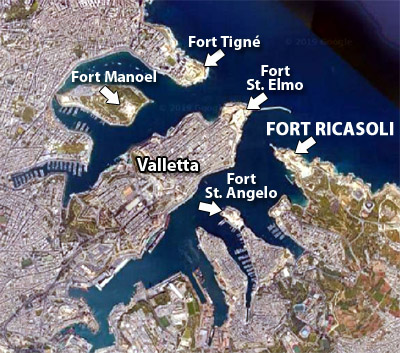 |
|
The Order of Knights of the Hospital of Saint John of Jerusalem (or Knights Hospitaller or Knights of St. John, because either one takes two minutes less to say than The Order of Knights of the Hospital of Saint John of Jerusalem), was a Catholic order that began in the 11th century in Jerusalem. As the word "hospital" suggests, they were dedicated to caring for and protecting pilgrims to the holy land. When that holy land was scooped up by the Fatimid Caliphate in 1099, the Knights took on a more militant role. They moved their base of operations to the Greek island of Rhodes, where they fought off various hordes of Barbary pirates, Egyptians and Ottomans.
In 1522 the Knights were violently ejected from Rhodes by Ottman Sultan Suleiman the Magnificent (1494-1566), after which they bonked around in Europe for a few years. Finally, Pope Clement VII (1478-1534), himself a Knight of the order in question, cut a deal with Spain's King Charles I for a new Knightly home, and the Knights of Many Names added another title: The Knights of Malta.
|
Coat of Arms of the Order of Malta/Knights of Malta/Whatever they were calling themselves that week. |
 |
The Maltese who were present on the island when the Knights showed up weren't particularly chuffed by this development. The Knights were an exclusive, high-handed bunch, who interacted with much of the island's female populace in a predictable way. They did build some extremely nice hospitals on the island, however, and provided security against Muslim attack...so the Maltese and Knights lived amongst one another in relative peace for 268 years.
Another thing the Knights of Malta built in great numbers were fortifications: So many fortifications. Malta is only 122 square miles in size, but the Knights walled up eight cities, built eight starforts, raised at least 37 defensive towers, and built around 35 batteries during their time on Malta, most of which were in the area of their capital city, Valletta. As one can surmise from the map at the top of this page, there are five impressive starforts within a stone's throw of one another surrounding Valletta's harbor. Why so many starforts so close together? Because the artillery intended to defend the harbor from all comers had very limited range...but also as we will shortly learn, the Knights were extremely well-funded (having a Pope in one's corner helps), and wanted their harbor to be absolutely impregnable.
|
|
|
Which it appeared to be for quite some time! The Ottomans weren't fans of these Christain barbarians setting up shop in what the Turks considered to be their stomping (splashing) grounds, and sent naval commander Turgut Reis (1485-1565) with 10,000 men to dislodge the Knights from Malta in 1551, which endeavor met with little success. The Knights had restored a dilapidated fort that had been left by Malta's previous occupants (Angevins? Aragonese?), named it Fort St. Angelo, and used it to hold out long enough for Turgut and his doodz to give up and head north to Gozo, Malta's northern island, to seek easier pickings.
|
Shortly after the Knights took up residence on Malta, there was a slave uprising. A group of disgruntled slaves attempted to take over Fort St. Angelo and then escape from the island, in 1531. The authorities (which were the Knights) couldn't have this sort of thing, so after putting down this rebellion they tortured and then hung twelve of the ringleaders on Punta Sottile, a peninsula on the eastern side of Valletta's harbor. This peninsula became thus known as Gallows' Point.
The Ottomans threw another 40,000 men at the Knights in 1565. Many of Malta's citizens rose to the occasion and fought alongside the Knights.
|
 |
The starforty side of Fort St. Angelo in Valletta, Malta. Now THAT is a BASTION! Google Earth, you rock my world, even if you do make trees and ships' sails look horrifying in 3D mode. |
|
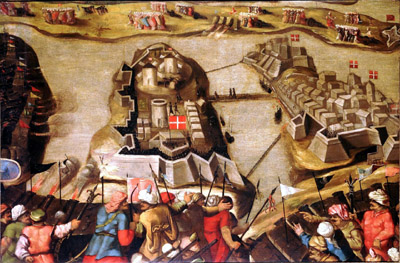 The Siege of Malta: Siege and Bombardment of St Michael, 28 June 1565, a painting from the late 16th century. Fort St. Michael on the Senglea peninsula is the focus of the Turkish attack, which is being undertaken by guns firing at it from the north, south and west. Fort St. Angelo is on the right, and a smidge of Fort St. Elmo is just visible in the top right corner. Note that the Knights' flag is still flying over Forts St. Michael and St. Angelo! The Siege of Malta: Siege and Bombardment of St Michael, 28 June 1565, a painting from the late 16th century. Fort St. Michael on the Senglea peninsula is the focus of the Turkish attack, which is being undertaken by guns firing at it from the north, south and west. Fort St. Angelo is on the right, and a smidge of Fort St. Elmo is just visible in the top right corner. Note that the Knights' flag is still flying over Forts St. Michael and St. Angelo! |
 |
The Great Siege of Malta lasted for four months through the summer of 1565, and it was a close thing for the Knights and Maltese: Vastly outnumbered, they managed to cling to just enough of their fortifications to make the poor dejected Ottomans leave, unfulfilled, once again.
This Ottoman defeat was a huge deal in Europe, as it was considered the first major victory over the previously-thought-to-have-been-at-least-nominally-invincible Turks. For many years the Ottomans had seemed an unstoppable monster, but here was clear evidence that they could be stopped. Money from the appreciative crowned heads of Europe poured into the Knights' coffers, and this was why they were financially capable of building so many starforts over the next couple hundred years. |
|
|
During the Great Siege, the Ottomans had built an artillery battery on Gallows' Point, to fire on Fort St. Elmo. St. Elmo had been captured by the Turks in the fracas, so it was plain that something had to be built to defend Gallows' Point. The Knights constructed San Petronio Battery, a semi-circular affair, on Gallows' Point in 1602, and added Torre San Petronio, a tower, in 1629. The tower and battery were surrounded by a sea-filled ditch and had a drawbridge: Defensible! In 1669, the Venetian city of Candia, on Crete, fell to the Turks. Crete is a mere 585 miles from Malta as the seagull flies, so the Knights felt it incumbent upon themselves to add to Valletta's fortifications. Italian military engineer Maurizio Valperga (1605-1688) arrived on Malta in 1670, and immediately began plans for Valletta's new defenses. He laid the first stone in a nearly three-mile-long wall that was intended to protect all of Valletta, which fortification needed an anchor on Gallows' Point: How about a starfort, he pondered?
|
And a starfort it was. Florentine Knight Giovanni Francesco Ricasoli (d. 1673) contributed 20,000 scudi (the Maltese scudo was the Order's official currency, and thus the currency of Malta until 1798...20,000 scudi was around $5400 in today's US dollars) to the construction of this new enterprise, which is why the guy got a starfort named after him: His contribution wound up covering about a fifth of what it cost to build the fort. Ricasoli was a commander in the Knights' navy, fighting the Barbary Pirates and Ottoman navy with great verve and industry, on several occasions.
Valperga oversaw the initial stages of Fort Ricasoli's construction: Its first stone was laid on June 15, 1670.
|
 |
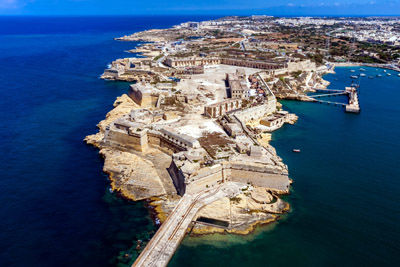 Fort Ricasoli from the northwest. Towards the rear of the fort one might note a reproduction Roman amphitheater: This was built for the 2000 movie Gladiator, some of which was filmed in this starfort! Fort Ricasoli from the northwest. Towards the rear of the fort one might note a reproduction Roman amphitheater: This was built for the 2000 movie Gladiator, some of which was filmed in this starfort! |
|
Enough of the fort had been completed by June of 1674 to install a "skeleton garrison," which was a small army of skeletons animated by stop-motion photography. Construction dragged on long enough for new engineers to show up on Malta, make sour faces at the progress, and make grand, sweeping improvement suggestions. One of these was Flemish architect Carlos de Grunenbergh (d. 1696), whose 1681 improvements for Fort Ricasoli and several other of Valletta's fortifications were implemented. In May of 1698, Fort Ricasoli was declared finished, fully armed, and ready for someone to come and attack it.
|
 What does it look inside a 350-year-old Maltese starfort? Not a whole lot different than what it looks like inside a 200-year-old American starfort! What does it look inside a 350-year-old Maltese starfort? Not a whole lot different than what it looks like inside a 200-year-old American starfort! |
 |
Which, frustratingly, did not occur right away. By the mid-18th century Fort Ricasoli had been allowed to deteriorate, and some work began in 1761 to restore it. In 1785 our fort was armed with eighty guns, including 41 24-pounders (which, as they are specifically mentioned, must mean that they were big 'uns in this context), making it the most heavily-armed fort on Malta.
Antoine Étienne de Tousard (1752-1813) was a Frenchman who served as Order of St. John's last military engineer. He came to Malta in 1792, where he oversaw some improvements to Fort Ricasoli. Tousard also designed Fort Tigné, Valletta's northernmost starfort. It is tempting to imagine that Tousard somehow planted the seeds of Malta's coming capitulation to Revolutionary France, but this does not seem to be the case. |
|
|
By the end of the 18th century the original mission of the Order of St. John, holding the line against the Ottomans, had become passé. The Knights had become less of an independent entity, and much more financially dependant on France. Enter the French Revolution, which started doing its thing in 1789: When France's monarchy went out the window, so did France's support for the Knights. So here we had a very fortified island bastion in a very desirable place for seafaring nations, with a very weak ownership. What could possibly go wrong?
|
Initially, Napoleon (1769-1821) went wrong. In 1798 his master plan was to capture Egypt, from which he would threaten British India, which was to cause Great Britain to soil itself and sue for peace. On its way to Egypt, Napoleon's fleet first stopped at Malta, parking itself in Valletta's harbor in order to reprovision, but SURPRISE, they were actually there to invade Malta! The French landed troops on June 10, 1798, and had little trouble overcoming the light resistance they met. Fort Ricasoli and Fort Manoel, on the other side of Valletta from the starfort of our current primary interest, withstood numerous French attacks, but capitulated when the Order officially surrendered Malta on June 12.
|
 |
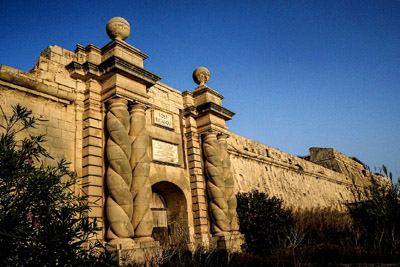 Fort Ricasoli's main gate. Too drunk to remember which of Valletta's many starforts you're standing in front of? Just read the sign above the gate! Fort Ricasoli's main gate. Too drunk to remember which of Valletta's many starforts you're standing in front of? Just read the sign above the gate! |
|
Many of the Knights of St. John left Malta and were given a new home by Russia's Emperor Paul I (1754-1801). The Maltese were initially relieved to be rid of the Knights, but the French swiftly revealed themselves to be even more obnoxious overlords, and within three months the Maltese rose against the French. With some assistance from Britain and Portugal, the Maltese soon secured the majority of their island, but the French remained ensconced in most of Valletta's starforts...including Fort Ricasoli. Once Britain's Royal Navy had destroyed the French fleet at the Battle of the Nile (August 1, 1798), they were at liberty to sail to Malta and see what they could do about the 3,000 Frenchmen thereupon.
|
 Fort St. Rocco, what's left today of San Rocco Battery, the Maltese battery that the French at Fort Ricasoli enjoyed shooting at. Fort St. Rocco, what's left today of San Rocco Battery, the Maltese battery that the French at Fort Ricasoli enjoyed shooting at. |
 |
The Royal Navy blockaded Valletta for the next two years, attempting to starve the French out. The Maltese and British constructed a series of batteries and redoubts in a chain around Valletta, further isolating the French.
San Rocco Battery was the part of this chain that lay closest to Fort Ricasoli. The battery was just to the southeast along the coast, a little under a half mile distant from our fort, and bore the brunt of the anger of Frenchmen who had little to do whilst under siege, other than fire cannons at things. |
|
|
Finally, having eaten everything consumable, and losing over 100 men a day from disease and starvation, the French surrendered in September of 1800. The Maltese offered their island to the British Empire, and 1814's Treaty of Paris made it official. British troops were all over the island prior to this, however, which leads us to Fort Ricosoli's next newsworthy event.
The Froberg Regiment was a unit of the British army that had been founded in 1803, specifically for service on Malta. It recruited men from various European countries, and included Poles, Albanians, Germans, Russians, Greeks, Swiss and Bulgarians. The process by which men were enticed into service with the British army were notoriously shady, but the Froberg Regiment apparently brought this art to new heights of underhandedness...or it may have been no worse than any incoming British soldier experienced, but with the added confusion of language barriers. Promised high rank and good pay, the men of the Froberg Regiment found themselves toiling as privates in the Maltese sun, for little pay.
|
Initially secluded on Manoel Island in Valletta's harbor, many in the Froberg Regiment demanded to be sent back to Corfu. Their officers replied no, you're in the British army! Those officers threatened to cut off the soldiers' food rations if they didn't stop whining, which stopped the whining, but didn't solve the Froberg Regiment's problem. The Regiment was released to mingle in Valletta, but quarrelled amongst themselves and were a nuisance to the locals, so they were confined to Fort Ricasoli, because how much trouble could they get into locked in a starfort?
As it turned out, plenty. On April 4, 1807, 200 Greek and Albanian Frobergers killed some of their officers and other folks they didn't care for, closed the gates and raised the Russian flag over Fort Ricasoli.
|
 |
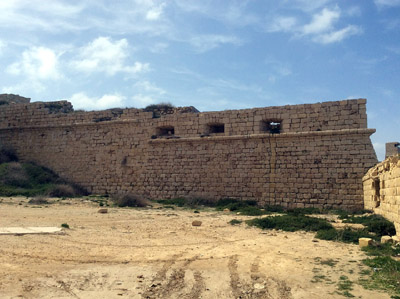 Fort Ricasoli's St. Dominic demibastion, where the Froberg Mutineers blew up the fort's powder magazine. Doesn't look like they did much damage to me, but maybe there have been repairs since 1807. Fort Ricasoli's St. Dominic demibastion, where the Froberg Mutineers blew up the fort's powder magazine. Doesn't look like they did much damage to me, but maybe there have been repairs since 1807. |
|
There followed a tense week in which the mutineers, holding several officers, British soldiers and their families hostage in Fort Ricasoli, threatened to fire upon Valletta unless they were provided with money, food, safe passage off of Malta, etc. Each of these demands was studiously ignored, and over time the increasingly hungry mutineers did their best to bargain, eventually releasing all of their hostages, hoping that someone would pay attention to them. Nobody did, so most of the mutineers decided to un-mutinize and scampered from the fort. The remaining, hardcore mutineers fired on Valletta on April 10, causing no injuries. The authorities finally got around to sending 40 guys into Fort Ricasoli to take it back shortly thereafter, during which adventure six mutineers managed to blow the fort's powder magazine. Mission accomplished! The mutineers were rounded up and done away with, as befits mutineers.
500 men garrisoned Fort Ricasoli in the 1840's, and starting in the 1850's higher caliber guns were installed on a regular basis. Improvements were made as well, and by the early 1900's our starfort bristled with searchlights, new gun emplacements and a torpedo station.
|
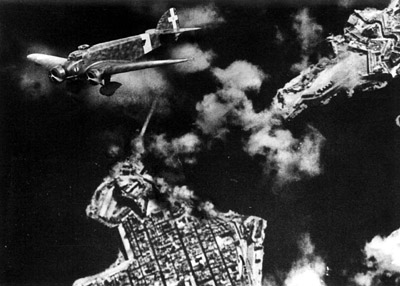 An Italian Savoia-Marchetti SM.79 Sparviero (Sparrow) over Valletta in 1941. Fort St. Elmo is directly under the bomber, and Fort Ricasoli is visible at top right. The SM.79 holds the honor of being the first type of aircraft to have crashed in flames on Malta! An Italian Savoia-Marchetti SM.79 Sparviero (Sparrow) over Valletta in 1941. Fort St. Elmo is directly under the bomber, and Fort Ricasoli is visible at top right. The SM.79 holds the honor of being the first type of aircraft to have crashed in flames on Malta! |
 |
In the interest of effing with the British, Italy and Germany bombed Valletta during the Second World War (1939-1945). Fort Ricasoli's guns helped to deter an Italian attack in July of 1941, and in April of the following year the Luftwaffe destroyed the fort's Governor's House and main gate. Despite this wanton destruction, the British managed to hang onto Malta through the war.
The Royal Navy took possession of Fort Ricasoli in 1947, rechristening it the HMS Ricasoli. This "starship" served as a barracks for naval personnel until 1958. As soon as everybody was allowed to call it a "fort" again, Fort Ricasoli's main gate was reconstructed in 1958, though no effort was made to make it resemble the original gate. |
|
|
Malta became an independent state in 1964, and Fort Ricasoli was abandoned. The ditch along the fort's landward side was soon filled with giant tanks to process liquid waste from ships, so as to make those liquids safe to dump into the sea. In the 1970's the St. Dominic demibastion, which had been damaged during the Froberg Rebellion, was further damaged by being breached to make a road into the fort. This facility is now run by the romantically-named Waste Oils Co. Ltd.
In the 21st century, Fort Ricasoli's interior has been used to represent ancient Rome, Troy and Alexandria in the movies Gladiator (2000), Troy (2004) and Agora (2009). The fort also stood in for the Red Keep in the first season of the wildly popular Game of Thrones.
|
Official inattention and the pounding surf have had their way with Fort Ricasoli: It's all falling apart, and some of it has already fallen into the sea. A serious restoration plan, projected to cost upwards of €50 million, was submitted to the Maltese authorities in May of 2013...and as of this writing, in June of 2019, that plan appears to have just been approved!
Starforts.com would love to take credit for bringing attention to the plight of Fort Ricasoli, but...here we are bringing attention to it after the plan has already been approved. You're welcome, Knights of Malta!
|
 |
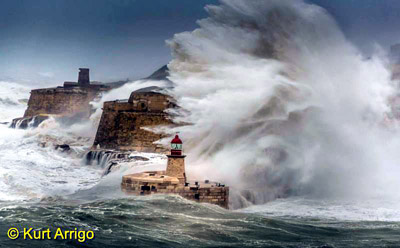 Imagine what hundreds of years of this does to a starfort! Thanks, ©Kurt Arrigo! Imagine what hundreds of years of this does to a starfort! Thanks, ©Kurt Arrigo! |
|
|
|
|
|
|
 |




